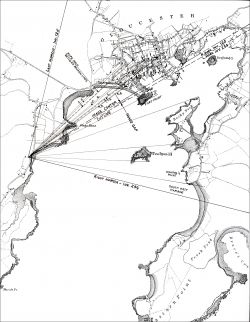loading 
Fitz Henry Lane
HISTORICAL ARCHIVE • CATALOGUE RAISONNÉ • EDUCATIONAL RESOURCE
An online project under the direction of the CAPE ANN MUSEUM
An online project under the direction of the CAPE ANN MUSEUM
Catalog entry
inv. 234
Across Gloucester Outer Harbor from Steepbank
Graphite on paper (2 sheets; drawing on left sheet) 10 1/2 x 29 in. (26.7 x 73.7 cm) Inscribed across bottom (in pencil): Across Gloucester Outer Harbor from Steepbank / F.H.Lane del. / Remnant of sketch at other end
|
Recto
Related Work in the Catalog
Supplementary Images
Provenance (Information known to date; research ongoing.)
the Artist, Gloucester, Mass.
Joseph L. Stevens, Jr., Gloucester, Mass.
Samuel H. Mansfield, Gloucester, Mass.
Cape Ann Museum, Gloucester, Mass., 1927
Marks & Labels
Marks: Inscribed upper left (in red ink): 100D [numbering system used by curator A. M. Brooks upon Samuel H. Mansfield's donation of the drawings to the Cape Ann Museum]
Exhibition History
No known exhibitions.Published References
Paintings and Drawings by Fitz Hugh Lane. Gloucester, MA: Cape Ann Historical Association, 1974., fig. 21, Not illustrated.



Commentary
This pencil drawing is the right half of Gloucester from Steepbank, c.1855 (inv. 125), the whole being a view of Gloucester Harbor from Western Avenue at the southwest corner of Fishermen’s Field (now Stage Fort Park). After cutting the drawing in half, this part was joined to a blank sheet of equal size. The reverse side was then used for the drawing Gloucester Outer Harbor, from the Cut, 1850s (inv. 109).
Separated from its left half, this drawing presents a very different scene, showing only the rocky southeast corner of Fishermen’s Field and a distant view of Rocky Neck and East Gloucester. For all its watery emptiness, this part of the scene would have been a great stimulus for Lane to occupy it with watercraft of types we can only imagine. To give some sense of the sizes of vessels at a distance, he has drawn a fishing schooner passing Ten Pound Island. This was a common occurrence in Lane’s harbor drawings as a means of determining the size of a vessel at a given distance. One of his drawings shows that he actually used linear perspective to this end (see View in Gloucester Harbor, 1850s (inv. 143)), but was apparently able to achieve realistic results without resorting to such efforts.
—Erik Ronnberg